The August 8th Update:
T still has not appeared. The weather has been not helpful, and the overcast clouds sometimes completely shut out the night. When doing my nightly checks, I am looking more and more westward for it. I hope that if it does go off soon, that it will be visible to us when it happens, and not when it reaches the meridian, when it will be behind the Sun's light and the blue of the late November daytime sky, which will obscure it from everyone's view on Earth.
I am also now wondering about the original report on this potential event. Jim Kaler, a respected professor at the Univ. of Illinois, had his own set of webpages about the sky. For T CrB ( http://stars.astro.illinois.edu/sow/epscrb.html ) he wrote that it had went nova back in 1866 and 1946. Making its nova's period 80 years, not 78 as recently reported. So, he expected it to happen again in 2026. He and others report that the system's orbital period is 227-8 days. Yet the observers at AAVSO.org seem to have recorded variances that its light curve peaks every 217 days. This suggests to me that the white dwarf is orbiting closer to the Red Giant star, is in a different part of the RG's accretion disk and so, is accumulating matter at a different rate, which could change when it goes off. So still, we can only watch and wait for the nova's flash to arrive.
The July 2nd Update:
T is still late for the party. The weather is something to contend with, and this past week, the clouds have been wispy, requiring patience to search for it. And now, I have noticed that even by 9:30 pm, I need to start facing west in order to look for the Corona Borealis constellation. Last night, the sky cleared out considerably, so I took advantage of it to do some maintenance on the star tracking alignment for the main telescope's gearing system, and take some images of the general region, "before it novas".
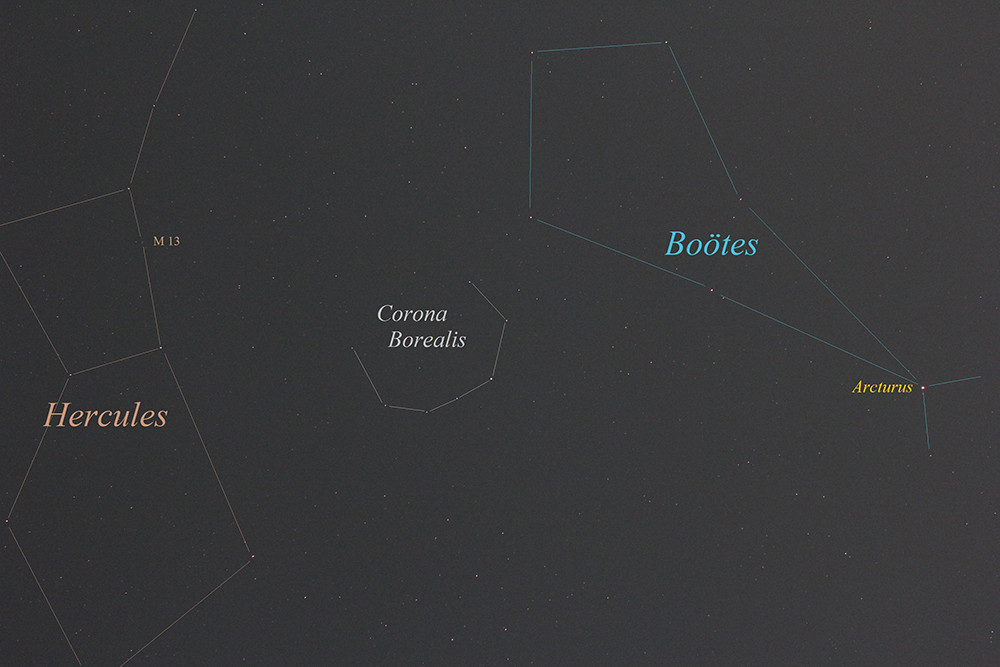
|
| This labelled image of the constellations around Corona Borealis was taken July 2nd, 2024 at 12:01 am, just behind FAU's Observatory. Labelled in Hercules is its great globular cluster M 13, found on the western side of its "keystone" asterism. Also identified is the star Arcturus in the constellation of Boötes. That star is what the "handle of the Big Dipper" arcs to in the sky. Follow its arc to Arcturus, so you can then find the curl of stars that make up Corona Borealis, the "crown north". |
I also attempted a close up of the Corona, and managed to capture some of T's light. I carefully doublechecked my star charts to verify that the "tiny smudge that is barely brighter than the background's average" really is from the system. I identified it with the red lines in the second image. Realize that that smudge, when it goes off, it will almost instantly brighten beyond the light from Alphecca, which is labeled 'α' there.
The July 26th Update:
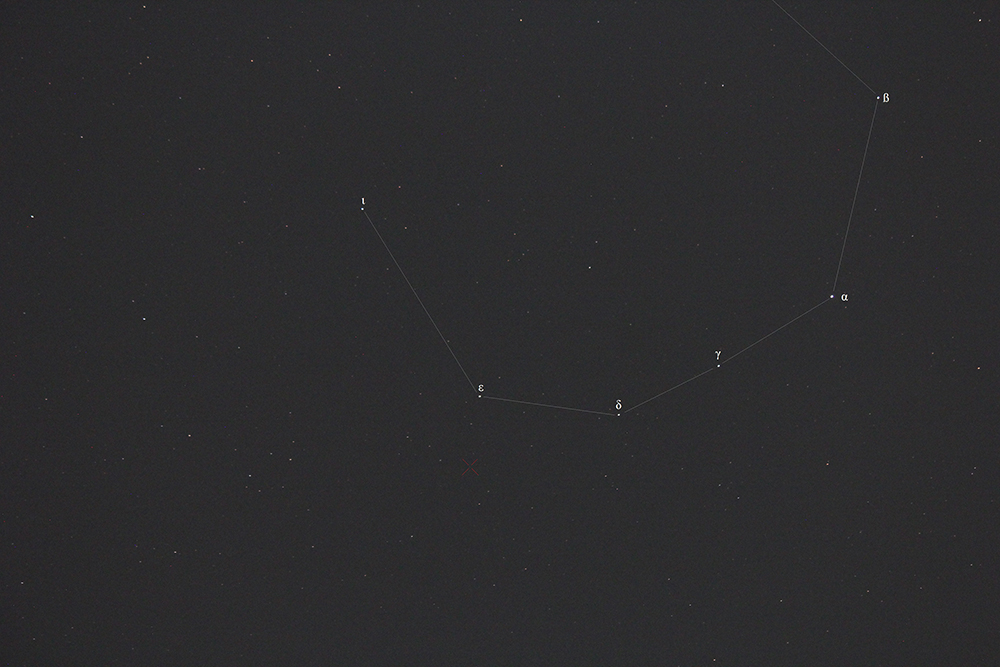
|
| This labelled image is of the Corona Borealis. It was taken the same morning, at 12:35 am, just behind FAU's Observatory. |
Well, to put it in a "badly Spanish and punny way": La Nova es quedo un no va. So, "the nova is still a no go", hasn't appeared yet, and the weather is making its search dicey. But when the clouds do move away, it's quite noticeable how clear the constellation is right above. My next goal is to get some pictures of the area, before it's flash arrives, to set up a before shot and be able to show the difference of when it does come. Just need the weather to help out with this. Stay tuned!
The June 25th Update:
Corona Borealis ("CrB") or the "crown north", is a faint constellation of a circlet of stars that lies midway between the star Arcturus in the constellation of Boötes and the "keystone" of Hercules. To find them, first locate the Big Dipper and note that its handle is "arced". Like the old saying goes: "Follow its arc to Arcturus, then spike south to Spica". Arcturus is a bright orange star on the image's lower left. The constellations in the region are faint. You should easily see the bright white Vega in the sky appear later to match itself on the image. Expect Arcturus to appear nearly overhead by 9 pm in early June, while the Corona will reach the meridian at midnight. Expect those times to shift 4 minutes earlier each night, and be 2 hours earlier each month going forewards. So by July, the Corona will reach the meridan by 10:30 pm.
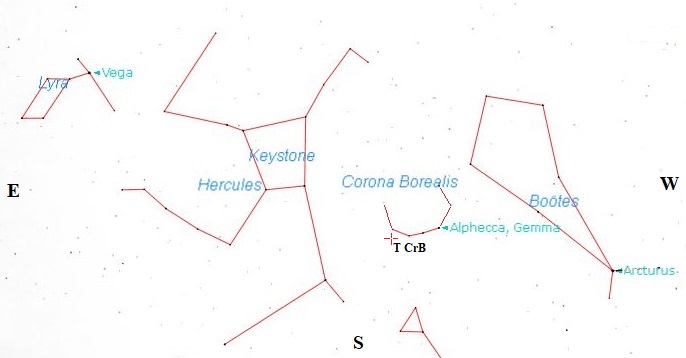
|
| The image shows the general region of the sky to help find the constellation of Corona Borealis. The Big Dipper would appear north of this view and to the west (so, to the upper right of the image). Print it out, go out at night, and hold it up as you are facing south. Observe it now, to become familar with the region before it briefly changes. |
In the direction of CrB, is a gravitationally bound, binary pair of stars, which has a red giant star that is being orbited by a white dwarf star. This system is called T Corona Borealis or "T CrB" for short, as indicated on the image above. It seems that the white dwarf is in a accretion disk surrounding the red giant star. AND in doing so, the dwarf star has been gaining mass.
When white dwarf stars gain enough mass, they have two reactions. Either they 1.) "ignite" that acquired surface mass in an instant fusion reaction explosion, like an "H-bomb/firecracker", that we call a NOVA. The PBS TV series has been hearlding the concept in its opening title movie for decades. Or 2.), they go supernova, type Ia. At its estimated distance of 806 pc (2628.85 ly), based on the numbers I can find, if the dwarf star were to go supernova type Ia, then it would appear in the sky with a brightness to have an apparent magnitude of m v=−9.77. It would NOT be as bright as a full Moon, but it would be brighter than the historic supernova of 1054 that everyone in the world saw (except apparently, for western Europe, which has no mention of it anywhere in its records!). The radiant light from this potential supernova would be concentrated from a single dot in the sky and certainly be bright enough for people to notice, even in the full day time. It would only do so, while the white dwarf is close to the necessary "Chandrasekhar limit" to do that, but its not quite there, yet.
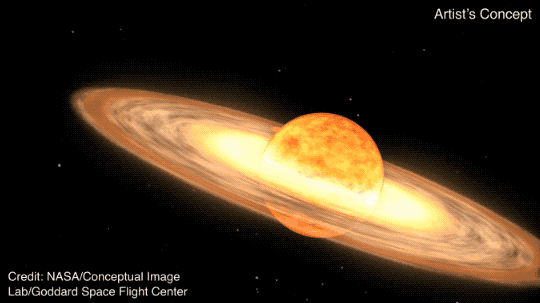
|
| A red giant star and white dwarf orbit each other in this animation of a nova. The red giant is a large sphere in shades of red, orange, and white, with the side facing the white dwarf the lightest shades. The white dwarf is hidden in a bright glow of white and yellows, which represent an accretion disk around the star. A stream of material, shown as a diffuse cloud of red, flows from the red giant to the white dwarf. The animation opens with the red giant on the right side of the screen, co-orbiting the white dwarf. The view shifts to the side as a nova explodes on the white dwarf. The flash fills the screen with white light. After the light fades, a ball of ejected nova material is shown in pale orange. A small white spot remains after the fog of material clears, indicating that the white dwarf has survived the explosion. Credit: NASA’s Goddard Space Flight Center |
So, we expect to witness the 1st reaction, in that, T CrB will go Nova soon and is estimated this year, before Septemer of 2024, with a "95% chance by this year's end". There are patterns to T CrB's brightness, from its last flare up in 1946. Hence, we expect it soon. And consider this, the system is so far away from us, that if that 78 year period is consistent, then the light of 33 more flare ups have already been released and are on their way to us right now, if it hadn't already gone supernova!
So, when precisely, will it arrive, you may ask? Well, we don't exactly know.
The amount of matter that falls on the white dwarf is not a clean, precisely known rate of accumulation. Its natural and chaotic, and so in that, it is kind of acts like the weather. But what we expect to see will be from a seemingly small blank part in the constellation's region (big telescopes can see it, but naked eyes cannot), the star will flare brightly enough to rival the north star Polaris, within a few short hours. The brightening will brief, just like any other big firecracker, in just a couple of days or up to perhaps a week, it will have faded back to obscurity for another 78 years. Which makes this once-in-a-lifetime event much rarer to see than a passage of Halley's Comet. For that comet comes around every 75.5 years, will do so in 2061, and people will be able to see it all summer long in the northern sky then. While T CrB's period is a little longer, as its appearance will be much shorter. So, it is rarer to see.
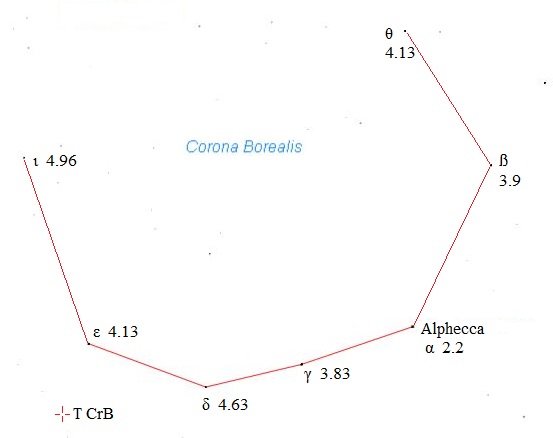
|
| This image is a close up of the constellation of the stars of Corona Borealis with their averaged apparent magnitudes. The magnitude numbers just give you a way to compare the brightness of the stars against each other. By our modern way of looking at it, the magnitude numbers "go backwards", in that, the dimmer the star, the greater the number. The stars' Greek letters, clockwise from the upper right, are pronounced as: Theta, Beta, Alpha, Gamma, Delta, Epsilon, and Iota. Look for T CrB outside the circlet, near Delta and Epsilon. |
And so, we watch and await for its appearance. You can print out the accompanying images to help you find the region in the sky. I recommend that people go out and look at the region now, before it goes off, so that when it does flare up later, you will be able to appreciate the appearance of a "new star" in the sky. At least, for that week, before it fades away. I am working on setting up a method to broadcast announcements about it when I see it do so and plan to open a special obseration session when it happens so that people can come as see it for themselves, too. Please stay tuned.
The Juneteenth Update: I wish all a Happy and safe Juneteenth!
The nova flash from T has still not arrived. I am still going out looking for it. There were a few nights of fully overcast weather during last week. Though lately, the clouds simply required more patience to wait for openings in them to reveal the absence of T. Its constellation now is nearly overhead at 10 pm. The amount of time that it is taking, means that it will appear further and further to the west when it does happen. Too much in that direction, could prevent us from seeing it in Observatory's main telescope. If that does become the case, then we would set something up outside with more mobile telescopes to view what we can of it.
The June 12th Update: Still no T. The weather has been irregular, requiring multiple checks on when to look for it every night. BUT NOW with this shift in the jet stream that is pulling in a lot of moisture from the Caribbean and the Gulf, we'll be clouded and rained out, practically for the remainder of the week and into next. Note that when T does go off, we'll only get about a week to actually see it. And then it will be finished for another 78 years. Hence, we could actually miss it!
So now I find myself hoping that T stays dormant a little while longer. But such hoping is really a silly thing, like "wishing on a star". After all, the stars are very far away. So that by the time your "wish" reaches the star, assuming it too travels at the speed of light, the Earth will have changed its position so much, that there is little likelihood that the star's "return granting of the wish" will be received correctly. So, if you are one who hopes that "stellar wishes" do work, then you'll have better luck to do so with the Sun, which is a poorly neglected entity for wish granting (so it has very little wish traffic to deal with) and is only 8.3 light minutes away!
The June 6th Update: T has not shown up. This past week, the Moon had been a waning crescent, and appeared ever dimmer and later after midnight. While a few overcast nights required using a timer to wake up and check on T, they were not too many. The other nights had clear enough skies to easily check on it. As it is later in the year, the Corona Borealis constellation is appearing higher in the sky. We now see it through less atmosphere, so its been clearer and more complete than I had seen it this year, even without optical aid, which was very nice.
If you have not looked for it, do so now. The constellation is easier to see and the Moon is new on the 6th, so it won't hinder your view much for the next week. To find the Corona, print out that image of the constellation's general region from above. After dark, go out with a red flashlight (red LED lights work best) to look at the page without damaging your night vision and try get away from any artificial lights as best you can. Find the Big Dipper in the sky and recall how the end stars in its "pot" point to the North Star, so you know which way north is. Follow the arc in the Dipper's handle to the bright orange star Arcturus, that's in the image. Hold the page above your head, oriented to match north and with its Arcturus appearing at the star's position. Arcturus is nearly overhead by 9 pm, and the Corona will reach the meridian at midnight. Then you can learn the Corona without T. So when it finally appears, you'll know it and can say to friends that's a new star in the sky!
The May 31st Update: Well, it seems that the April and May expected prediction for T CrB's nova flash was a washout. It has still not appeared. The weather has been quite uncooperative, especially as the nights had started. So that, in order to check on the system, I had been setting timers to wake me up after the expected clearing of the sky, which normally occurred after midnight. For the last three nights, I needed to wake up at 2, 3:30 and 1:30 am to do so. It is rather tiring, but what is nice is that when I am able to see the corona constellation, it appears high overhead and is clearly brighter, with its stars seemingly crisper than when it is lower near the horizon. We look at it through much less atmosphere then, so there is less blurring effects from the ever dynamic air upon its view. Newer projections have promised a certainty of the nova flash happening, by at least the end of the year.
I am very much hoping that when the nova flash does appear, that the weather will be clear in the early evening, so that people can come and see it. For we all know here in South Florida, that a new hurricane season is just starting tomorrow. As such, do consider what preparations that you need to do, such as trimming back tree branches that threaten your homes or making big purchases that you can put away for later. For the projections of this season promises to be one of the most active that we have ever seen.
The May 24th Update: So far, T CrB's nova flash is still a no show. This update is later than I would normally do, as I have needed to focus on my family's needs and took some time off to do so. The weather had been cloudy and somewhat rainy. So, waiting out the clouds to check on T, means that I am looking at it later and later in the night, and so its getting higher and higher in the sky then. And so the whole Corona constellation has been appearing brighter and crisper, though only its brightest star, Alphecca, is visible to my naked eye where I live. Corona Borealis is an example constellation that is being entirely erased from our skies by our artificial light pollution. Another is Hercules the hero and almost all of Bootes, too. Arcturus, its brightest star, the brightest star in the northern hemisphere and 4th brightest of any that we see, is still quite apparent, so its not endanger of being blurred away by our luminous fog of artificial light. But is by its location in a constellation that helps one recognize what star it is. Our artificial light has a profound effect on the nighttime environment, especially for half of all animals that start their daily existence at sunset, such as insects. For example, those who always live in a suburban bubble of artificial lights at night, try to recall when was the last time you actually had to scrap dead insects off of your car's windshield? Then head over to our page on Light Pollution vs Insects to understand better the vacuum cleaner effects of lights and realize that insects are the bottom level of a protein food pyramid that feeds so many other species of animals, which they in turn feed us. Rachel Carson once warned us about the dangers of DDT sprayings against mosquitos and how such chemical poisonings get concentrated back up the food chain to causing problems for top animal species that could lead to a silent spring. Know that there is more than one pathway to such a dismal end.
Dark nights are natural. We can't just keep filling nights with our artificial lights.
The May 13th Update: Yes, we still are seeking the nova flash from T. The observer's reports from the AASVO show a variety of measured values of its brightness. Which could be due to differences in their locations' backgrounds, the observers's capabilities or their methods. While that may sound like a flaw in the data sets, it isn't really, as long as each observer stays consistent to their own methods of measurement. Then, changes in the light levels of white dwarf source, should be measured by each observer in their same way. And that is what the reports show. They all noisily show oscillations in the brightness of the white dwarf/red giant system that is a little bit shorter to the expected orbital period (from their current data, I'm reading the system orbits at 218 days compared to 227.8 days from a year 2000 report), and they are all in phase with each other. In that the peaks of the oscillations in each data set, are all occuring at the same time. That's good. Some sets show a decline in its overall brightness, others do not, but nothing too majorly different.
Lately, the weather is becoming a bit more cloudy here in South Florida, but it hasn't really been raining. It has been dry as the plants are parched, so they could use the rain. The rainy season here is supposed to start on the 15th, according to the NWS. However, with or with out rain, the clouds are still there and the past couple of nights, they seem to me to be obeying a "Murphy's Law" regarding clouds and astronomical observations. In that, whatever it is I am looking for in the sky, a cloud will not only quickly come and block my view, but it will be elongated in such as way, to maximize its coverage of what I'm seeking! I used to think that astronomy requires lots of patience when doing it, but I think that really its the weather that requires it. Anyway, I am still searching for this expected flash and will keep posting about it. Until then, clear, dark and starry night skies to you!
The May 6th Update: Still awaiting for T's appearance. Its rise time keeps getting earlier, so it appears higher up in the sky when it gets dark. That makes its constellation clearer and brighter to see, as we're looking through less of our atmosphere that would blur its view. Do expect the same for yourselves, if you go out to look for it.
This weekend my autistic son saw me come back indoors from checking on T, and he wanted to go out and look through my binoculars, too. So we went out, with him wearing its strap, and me helping him focus it. When he used them to look down the road, he really seemed to understand its function better this time. So we started walking around our HOA neighborhood for different views, but then he loudly declared over and over how he "could see so far!" and that he was a "spy on people!" Where he got that line, I don't know. Whether any of the neighbors heard him, I don't know either, but be assured that we are not looking into people's homes!
Anyway, if you go out tonight, May 6th, do remember to also stay out and look towards Cape Canaveral at 10:34 p.m. ET for the ULA (United Launch Alliance) Atlas V rocket and Boeing Starliner spacecraft launch!
The April 31st Update: I am still checking, but T has not shown up yet. Each week that goes by, the constellation's rise time occurs about a half an hour earlier. So, while some students in Intro to Astronomy classes may not appreciate the effect, doing this watch makes it very apparent and real. When I started this, it was quite dark and the family was already in bed. Now, it rises when its time to clean up from dinner and get everyone to bed, and it is getting in the way of that domestic effort. So, by the end of May, its rise time will occur over 2.5 hours before the Sun sets.
The time that our watches and clocks measure is the "solar time" or the average amount of time it takes for a telescope to measure the Sun from the meridian to the meridian the next day, or 24 hours. However, stars rise according to "sidereal time" or the amount of time it takes a star at the meridian to appear at the meridian again the next day, which is 23 hours, 56 minutes and 4 seconds. The reason that there is a difference is that the Earth orbits the Sun, and so it moves forward in its orbit by about a degree (360° in a circle is from the Babylonian's counting of the days there are in a year. Measuring techniques were not needed to be as precise as we are today. So to compensate for the difference, they would just add a month into their calendar, when they needed to make corrections, about every 5 years. They were so enamoured with the idea that 6 sixites, or 360, equaled the days in the year, that they based their entire numeric counting system on 6 and 60. Ultimately that math by 60s is what later ancient Greek scientists learned how to do, and they encorperated that counting into their geometric math and angle measurements, which later got encorporated into our measurements of 60 minute and 60 second increments for our clocks. So, when you look at a clock today, realize that you are using a counting system that is over 4000 years old! AND you can explain that to your kids why there are 60 minutes in an hour, because of ancient peoples methods to make astronomical time measurements.)
This means that sidereal times are true 360° measured rotations. While, to get the Sun to appear back in the telescope for the solar day measured time, the Earth has to rotate an additional degree, or 361°. Anyway, I haven't seen the nova yet and will announce when I do.
The April 24th Update:
Still checking on T, but no change yet.
BUT as it keeps rising earlier every night, it's now doing so while neighbors are walking their dogs. Met a couple doing so last night, told them about it's potential appearance, and how to find it. They were quite interested in it.
If any of you are trying to check on T, as well, then please do share what you know about it with others. That way they can share it's wonder and excitement, when it happens, too!
The April 15th Update: It's not T's time yet! So far, nothing new to report. The nightly change of the rise time for the constellation is easier to deal with. Tonight, expect Corona Borealis will rise about at 9:20 pm.
The April 8th Update: I'm still going out each night to look for T CrB, but nothing, so far. It may not seem like it at first, but the nightly change of the constellation's rise time is quite noticeable. If you go out, expect that Corona Borealis will rise at 9:50 pm.
The April 1st Update: I have been going out every night to observe the appearance of T CrB outburst, but so far, nothing yet. I'll get some pictures of the region soon. If you try to go out, expect that Corona Borealis will rise at 10:10 pm, so its geting easier to check on.